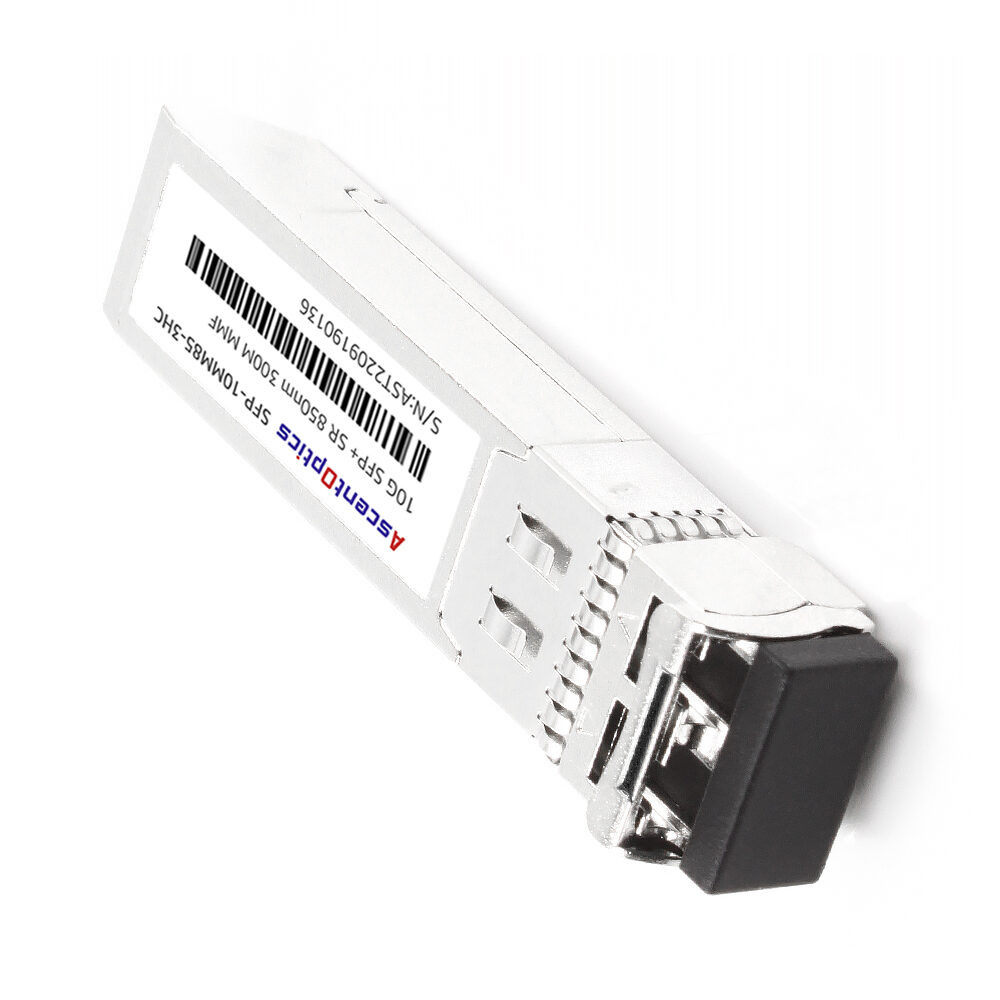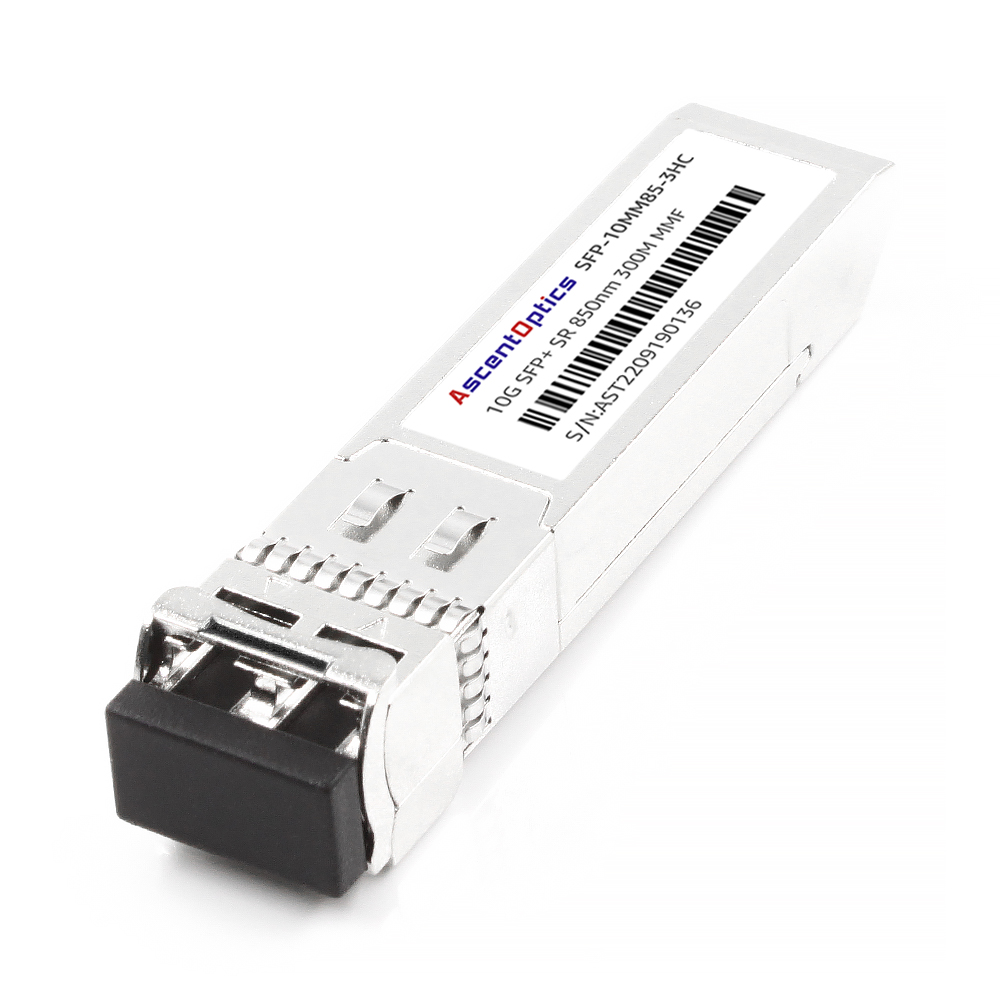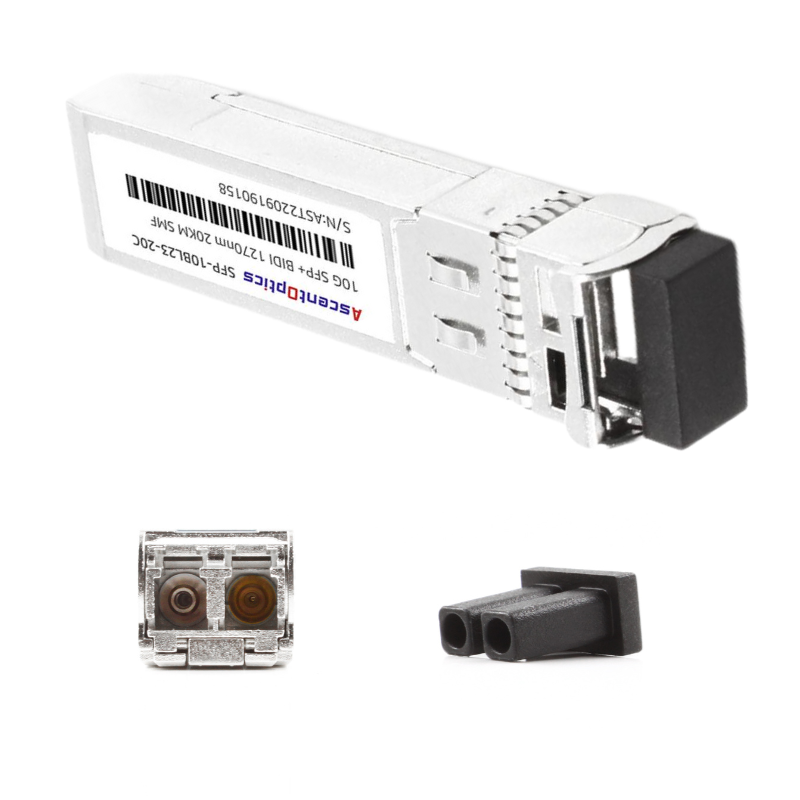This all-inclusive manual will walk through the Cisco Meraki MA-SFP-10GB-SR, a 10GBASE-SR optical transceiver with high performance that is meant to change the way you think about networking. For those who want to improve the speed and efficiency of their networks, this guide provides an overview of features, capabilities and use cases for the transceiver in real-world scenarios. Whether you’re an experienced IT professional or just starting out with network infrastructure, it’s important to know how optical transceivers like the MA-SFP-10GB-SR can help drive operational efficiencies and create a seamless high-speed network environment. Come along as we demystify this cutting-edge device by sharing tips, tricks and insights into maximizing its potential for meeting your networking needs.

The MA-SFP-10GB-SR optical transceiver has a lot of features that are meant to make your network perform better. Here is a simple breakdown of its features:
Each feature helps the MA-SFP-10GB-SR provide fast and dependable connectivity required by current network environments. If you are upgrading your current system or setting up a new one, it is important to know what each feature does so that you can make informed decisions about your networking hardware.
To ensure that the MA-SFP-10GB-SR works well at an 850nm wavelength and covers a maximum distance of 300 meters when Digital Optical Monitoring (DOM) is enabled, several requirements must be fulfilled.
If these conditions are met, then MA-SFP-10GB-SR will function optimally thereby providing fast and reliable connectivity up to its maximum stipulated distance under the 850nm 300m DOM specifications design.
To make certain that major brand switches and routers can be easily integrated with it, the MA-SFP-10GB-SR is designed to be widely compatible across a broad range of network equipment. The industry has widely adopted the LC duplex connector type because of its small size and ease of use. This kind of connection is very important for maintaining high-speed data transmission since the LC connector provides a secure and stable link. Moreover, this transceiver works well with OM3 as well as OM4 fibers which are preferred for high-speed network backbones. By using them, you can achieve the best performance possible while still ensuring compatibility so that you do not encounter signal integrity-related problems or any other issues with network reliability.

To identify Cisco Meraki devices compatible with the MA-SFP-10GB-SR transceiver, you need to look at the hardware specifications of the device and SFP+ port availability in the datasheets. Most of Cisco Meraki switches and routers that support 10 Gbps SFP+ modules will be able to work with MA-SFP-10GB-SR without any issue. This covers well-known types such as those coming from the MS or MX series by Cisco Meraki that are designed for fast network environments. Make sure to always update your firmware up-to-date, which is necessary for ensuring maximum performance and compatibility.
The capability of the network can be greatly improved by changing to 10GBASE-SR SFP modules. This offers businesses faster data transmission rates and higher network performance. The new technology caters to the need for greater bandwidth in current IT systems by enabling faster and more reliable movement of information between devices connected on a LAN or WAN. It is used within short-range optical communication systems designed around multi-mode fibers that are up to 300 meters long when discussing the 10GBASE-SR standard. These features make it possible for companies to achieve high levels of performance in their data centers; this will also lead to increased operational flexibility while supporting applications with very high bandwidth needs without compromising the security or integrity of data passing through such networks. Any organization that hopes to keep pace with future technological advancements must undertake this kind of upgrade, thereby positioning itself better vis-à-vis competitors within the digital realm.
Here are some tips to ensure that your 10GBASE-SR SFP modules are at their best:
If followed correctly, these points will go a long way in helping you boost efficiency as well as reliability within your system, hence enabling all features present in each module to work together seamlessly, thus giving you full satisfaction from the 10GBASE SR SFPs.

To evaluate the compatibility between Meraki and non-Meraki transceivers, it should be understood that all Meraki devices are made to operate normally with only Meraki-branded transceivers. This is done to ascertain full compatibility and the best performance possible. However, some third-party transceivers claim to work well with Meraki equipment, too. Although they can save money, these may need extra steps to be recognized or operated within a Meraki environment, like manually configuring settings or updating device firmware so as to accept non-Meraki SFPs. To avoid any network issues or downtime, ensure you check whether specific models of other brands’ optical modules are compatible with different versions of Meraki’s firmware. Warranty and support services by Merake could also be affected when you use third-party transceivers.
Concerning the integration of third-party transceivers with Meraki devices, it is necessary to evaluate their impact on warranty and support services. According to Meraki, if any non-Meraki SFP modules are used, then the warranty might be voided, which means that there can be no vendor support for hardware failures or network problems. Furthermore, there could be a need for reproducing an issue using Meraki transceivers before support will continue investigating cases involving other brands’ transceivers; therefore, this should also be taken into account while thinking about savings from choosing cheaper alternatives against possible risks and limitations on warranty and support services. Always check what the current policy says about using other manufacturers’ products with Meraki gear before making your decision.
Choosing to use third-party transceivers that are compatible with Meraki requires a thoughtful cost-benefit analysis. On the one hand, non-Meraki options can be much cheaper than those branded by Meraki, which makes them particularly attractive for saving money in big installations. Conversely, there may still be some problems like compatibility issues, manual configuration requirements, or warranty cancellation. These disadvantages have the potential to result in hidden expenses such as reduced support responsiveness and network downtime. That is why even though initial financial savings might seem good at first glance, organizations need to consider TCO (Total Cost of Ownership) vis-à-vis reliability plus support from Meraki against risks associated with third-party alternatives. This should ensure that the stability and maintainability of networks aren’t compromised based on this evaluation while making decisions about what will work best for an organization’s network in terms of stability as well as manageability.
The 10GBase-SR is a specification for multi-mode fiber optic cables used widely in short-distance data communication and networking. This standard is favored because of its low cost and efficiency in local area networks, data centers, and high-speed enterprise connections. Here’s what you need to know about it:
When you plan your network infrastructure, remember these specifications in order to ensure compatibility between different devices as well as enhance overall connection speeds throughout your establishment.
By allowing continuous observation of significant figures, Digital Optical Monitoring (DOM) helps to oversee MA-SFP-10GB-SR module. The temperature of the transceiver, laser bias current, transmitted optical power, and received optical power are among such measures. By providing this information for anyone who needs it, network administrators can keep their systems in top shape as well as detect problems early enough to prevent major downtime events. In other words, this is more like preventive maintenance which improves reliability and efficiency for any network infrastructure that uses MA-SFP-10GB-SR transceivers.
To ensure good connectivity at 850nm for distances as far as 300 meters using Digital Optical Monitoring (DOM) in duplex configurations, the Multi-Mode Fiber (MMF) must be of appropriate quality and specification. In other words, this means that OM3 or OM4 fibers are recommended. With OM3 fiber, you can go up to 300m, while with OM4 fiber, you can support even longer distances, which makes it better for high-speed data transmission. For optimal data throughput and reliability, it is important to use a fiber optic cable that matches the capabilities of the transceiver being used. Apart from this, signal quality over the specified distance may also be affected by physical factors like the cleanliness of connectors or sharp bends in the fiber, which should therefore be avoided.

For MA-SFP-10GB-SR transceivers to be reliable, it is necessary to carry out a complete test and certification process. This includes tough trials of performance in different environments aimed at simulating its usage under normal conditions; this may involve fluctuating temperatures, varying humidity levels, or even electrical interferences, among others. Optical power output tests are done on every transceiver while sensitivity is also checked and the transceiver should meet strict latency requirements. Moreover, these devices are made compatible with various network equipment so that they can work well in diverse operational environments. Certification from recognized standard organizations also serves as an assurance for the quality and dependability of such devices, which gives confidence to system administrators about their network infrastructure’s robustness as well as its efficiency over time.
The MA-SFP-10GB-SR module is considered to have great data transmission performance. It can handle up to 10 Gbps of data on multimode fiber with two standard options, OM3 and OM4, allowing for coverage of 300m and 400m, respectively. For this reason, it is perfect for use in data centers or campus networks where medium distances need to be covered. The low latency and high throughput provided by this product ensures that networks run smoothly even when dealing with heavy traffic loads, which is very important, especially during streaming media playback or large-scale cloud computing. In addition, it also works well with many different types of devices, so integration should not pose any problems whatsoever, thus making this device ideal for upgrading existing infrastructures without causing incompatibility errors and simplifying expansion plans too, because there will be no need for complex rewiring tasks or expensive hardware replacements.
By using the Cisco Meraki MX450 router and other routers, such as the MA-SFP-10GB-SR, one can see how valuable connectivity solutions are to network designs. More specifically, this means that bandwidths may be multiplied and data traffic could be made faster while security is guaranteed within the whole connection. Auto VPN peering or traffic shaping, among other high-speed capabilities of the Cisco Meraki MX450, together with MA-SFP-10GB-SR, enables quick optimization of network traffic by administrators who also have an opportunity to manage it effectively. There is no need to worry about speed reduction or quality loss because this integration supports many applications like HD video conferences up cloud services without any compromise on them. In addition, when used in conjunction with each other Cisco Meraki’s strong safety measures inherent in its system combined with performance reliability offered by MA-SFP-10GB-SR establish a foundation for end-to-end secure networks that are not only fast but efficient too.

The MA-SFP-10GB-SR module can be optimized by carefully selecting the right accessories. For example, using 10GBASE-SR-compliant cables made from high-quality fiber optics ensures that data is transmitted at the maximum rate with minimal signal loss. Besides, a strong network rack or enclosure should be used to house and secure physical hardware components. In places where there is likely to be interference with data, shielded connectors and cables can greatly improve signal integrity. Lastly, it would be wise to invest in an all-inclusive network management software tool that enables monitoring and maintenance of network performance in real-time thereby allowing for immediate identification and resolution of any emerging challenges. These add-ons not only boost the efficiency but also the reliability of this equipment while contributing towards a more dependable network infrastructure as a whole.
While selecting optical transceiver modules for network expansion, it is important to look at compatibility, performance, and cost effectiveness. This MA-SFP-10GB-SR module has been designed as a standard for high speed data transmission over short distances. However, there might be other models needed to be considered during network expansion so as to cater for different distances and speeds.
By following these basics – compatibility, distance coverage capacity, rate per second achieved during communication exchange between points connected together within a given geographical area spanned by the organization’s premises or branch offices scattered throughout various locations, etc., one will be able to achieve the best results.
At Rhino Networks, we consider ourselves the only source you will need for Cisco Meraki solutions. We know that today’s networks have many different and complicated requirements so we carefully choose what goes into our catalog; this includes a variety of Cisco Meraki modules that cover various distances, data rates and budgets. Whether it’s for an office with limited space or a company with locations around the world – no matter how big or small — our products are designed to be compatible everywhere while delivering the best possible performance at every price point. With Rhino Networks’ help, organizations can configure their networks to run faster and more reliably than ever before, which is why we are recognized as the leading provider of Cisco Meraki products among businesses worldwide who want to take full advantage of them.
1. “Cisco Meraki MA-SFP-10GB-SR Transceiver Module Overview” – Cisco Meraki
The official documentation of Cisco Meraki offers a detailed overview about the Optical Transceiver Module MA-SFP-10GB-SR explaining how it works with other devices in the network and enable fast data transmission across networks. The technical specifications, installation guide and troubleshooting tips provided by this source makes it valuable for those who want to utilize this transceiver on their networks.
2. “Optimizing Network Performance with Cisco Meraki MA-SFP-10GB-SR Transceivers” – Network World
This Network World article looks at how the Cisco Meraki MA-SFP-10GB-SR Optical Transceiver can be used practically to optimize network performance. It talks about where the transceiver is best suited in real-world scenarios such as data centers, cloud environments, and enterprise networks. By giving information on how we can make use of these optic features for greater efficiency within our networks, this resource provides useful insights to IT professionals who are seeking ways through which they can maximize their networking capabilities.
3. “Enhanced Connectivity with Cisco Meraki MA-SFP-10GB-SR: A Case Study Approach” – TechTarget
TechTarget takes a case study-based approach when exploring the Cisco Meraki MA-SFP-10GB-SR Optical Transceiver, thus showing how businesses have used it to achieve better connectivity and improved performance across their networks. The author highlights successful implementation stories along with some key benefits realized by organizations that have adopted this particular transceiver device in their network infrastructure setups. This content is most relevant for decision-makers who would like practical results and pros of integrating such kinds of transceivers into their current or planned network architectures.
A: An optical transceiver, 10GBASE-SR, is designed by the Cisco Meraki MA-SFP-10GB-SR for high-speed networking over fiber optic cables. It benefits your network infrastructure by providing fast 10Gbps connections for short distances, such as up to 400m over OM4 fiber, ensuring high-performance and efficient data transfer necessary for things like video streaming, cloud computing as well as data center connectivity.
A: Yes, the range of compatible Cisco meraki devices includes MX250, MX450 and MX600 models among others. They are plug-and-play thus making it easy to upgrade your network infrastructure with high-speed fiber connectivity.
A: Although optimized for specific cisco merakis, this device follows industry standard specifications hence can be used on non-Meraki systems supporting 10GBASE-SR SFP+ transceivers but compatibility should be confirmed from device manufacturer so that it functions properly.
A: Key technical specifications include a 10Gbps data rate (10Gbe) and a wavelength of 850nm, which indicates whether an application is SR or not. This is also known as short-reach applications and LC duplex connectors. It complies with multi-mode fiber optic cabling systems because it is compliant with standards set by BASESR, where base stands for Broadband Access Serving Ethernet Service Route through Single Mode Fiber Optic Cable or Duplexed Patch Cord Kit.
A: The Meraki MS425P-HW is best used with OM3 or OM4 multi-mode fiber optic cables that have LC connectors because these allow for high speeds over long distances provided by 10GBASE-SR SFP+ transceivers.
A: Cisco Merakis plus their MA-SFP-10GB-SR counterparts offer an unbeatable combination – they seamlessly integrate, and are easily managed via the Meraki Dashboard, thereby enabling businesses to deploy efficient, secure, scalable networks without having to deal with complexities usually associated with high-speed fiber infrastructure.
A: Yes, this device complies with IEEE 802.3ae which is a standard for 10BASESR ensuring top performance as well as reliability; it also certified for use under different regulatory domains so you should check local regulations before deploying them.
A: Before inserting the transceiver into your device’s appropriate SFP+ port, ensure that power is off on both sides. Once inserted, fasten it securely using an LC cable. When powered on, verify connectivity and operational status through comprehensive monitoring features offered by Meraki Dashboard.